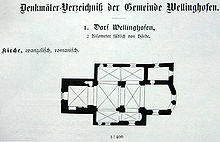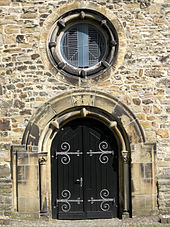Wellinghofen old church
The Old Church Wellinghofen is a Romanesque church building in Dortmund 's Wellinghofen district . The church belongs to the Protestant parish Wellinghofen.
Origins of the Church
The origins of the church can be dated to the 9th century. In 1977, remnants of the foundations of a simple hall with a rectangular choir closure were found during renovation work in the church . The basic rectangular shape of the small hall church and the width of the wall foundations, which were between 65 and 70 centimeters, as well as the wall technology point to a late Carolingian construction period in the second half of the 9th century. Traces of fire were found in the foundations, indicating that the original church had been destroyed by fire. This fire cannot be precisely dated, apparently it destroyed the original church in the 12th century.
A Romanesque cruciform church was built on the foundations of this church in the 12th century . Three apses closed off the choir and aisles to the east. The dimensions of the nave remained within the framework of the old foundations. The tower probably also comes from this construction period. In the Middle Ages, the church served as a resting place on the pilgrimage route to Syburg . The ornamental painting of this church was rediscovered and restored in 1978. The nave of this church corresponds to the central nave of today's church.
In the 14th century the church was converted into a hall church. The original end of the church with three apses was removed by rebuilding the central apse. The southern smaller apse has been preserved, the northern one fell victim to the later addition of a sacristy.
A Gothic tabernacle with a tympanum and an approximately thousand-year-old baptismal font have also been preserved. Noteworthy are the windows of the church based on a design by Wilhelm Buschulte (purely geometrical window design with largely no color). A bell that was cast in the 13th century is still in use in the church tower. It is considered to be one of the oldest bells in Westphalia.
According to non-written tradition, the church bore the patronage of Saints Chrysanthus and Daria .
The old church Wellinghofen was under the patronage of the family von Romberg . Between 1903 and 1907, the church was given its present-day appearance through renewed renovation and expansion of the choir.
The church is registered as an architectural monument in the list of monuments of the city of Dortmund .
organ
Original expansion
The organ of the old church was planned and built in 1709 by the cantor of the Reinoldi church in Dortmund, Johann Georg Alberti, at a price of 320 thalers . Muster was an organ by Alberti in Witten. Parts of the contract are still available today:
“... between the noble priests and church councils of the said Reformed congregation and Mr. Johann Georgen Alberti to the glory of God in the church in Wellinghofen, make an organ like the Wittensche ahn structure, voices and register, and set up those of the Wittens in all accordant The organ is to be delivered completely ready towards midsummer for the future thousand seven hundred tenth year and is to be erected in the church in Wellinghofen and set in a perfect state without punishment ... "
The organ, financed by the Reformed congregation, led to conflicts with the Lutherans, who were allowed to use the church by order of the Great Elector . In 1713 it was agreed that the Lutherans had to pay half of the purchase price.
The instrument was initially single-manual and did not have a pedal . Originally it is said to have been placed on a gallery in the tower, that is, in the longitudinal direction of the church. The Reformed preacher Grevel wrote in his "Church history of the parish Wellinghofen" from 1811:
“The organ is attached to the tower and rests on two wooden pillars, which stand in the nave of the church and are only 7 feet [approx. 2.10 m] are high. "
Conversions
The organ has been rebuilt and relocated several times over the centuries. In the years 1857/58 the Dortmund organ builder Carl Herbst expanded the organ to include a pedal with 3 registers and a twin drawer , which enabled the installation of a second manual. Herbst, whose work followed the example of Johann Friedrich Schulze , continued to add various 8 ' registers .
In the years 1903–1907 the old choir was built by a choir built in neo-Gothic style with a 5/8 degree by the architect Gustav Mucke . At that time the organ was placed on a new gallery in the eastern part of the north aisle. A part of the baroque prospectus is covered by a vault. The old sacristy , which is being replaced by an extension in the south of the church, now serves as access to the organ gallery .
During the Second World War the organ was badly damaged, which gave rise to a renewed renovation. Under the influence of the expert Arno Schönstedt , the sound of the organ was again aligned more closely to its baroque origins. The organ builder Willi Peter from Cologne developed today's disposition of the instrument. The location was relocated to the west and in front of the vault so that the baroque prospect of the organ was visible again.
In 1951 a motor for the blower was built. The last renovation took place in 1972 and 1973 by the organ building company Gustav Steinmann from Vlotho after damage from woodworm infestation, temperature gradients and dust. The pedals were renewed.
In 2003 the condition of the organ was analyzed by the Bonn organ builder Johannes Klais Orgelbau . 117 pipes are still from the original Alberti organ, but some have been changed. 95 pipes come from the renovation by Carl Herbst in 1858. With 576 pipes, most of the registers from Willi Peters' work come from 1951. 81 pipes come from the replacement of the damaged pedal register by the Steinmann company in 1972.
Bells
The old tower now has a four-part bronze bell. The old prayer bell in e ', cast in 1665, and a particularly old bell from the 13th century (f sharp ") have been preserved. For decades the prayer bell was the only existing bell. In 2006 the Bachert foundry cast two new bells in c sharp and a ". In the course of the expansion, the ringing bell of the 13th century was made ringable again.
literature
- Martin Blindow: Organ history of the city of Dortmund. A documentation from the beginnings to the 20th century . Series: Music: Research and Science Vol. 2, 2008, 264 pp., ISBN 978-3-8258-0895-2 .
- FGHJ Bädeker; Heinrich Heppe : History of the Protestant congregations in Grafschaft Mark and the neighboring congregations of Dortmund, Soest, Lippstadt, Essen ; Iserlohn (Bädeker) 1870.
- Dore Bolege-Vieweg: Dortmund village churches, treasures of medieval art . Ruhfus publishing house. 1998.
- Hilde Claussen: On the color of church rooms of the 12th and 13th centuries in Westphalia . In: Westfalen, Vol. 56, 1978.
- Cornelia Heintz: Dortmund-Wellinghofen, Evangelical Parish Church . In the series: Schnell Kunstführer No. 1379, Munich and Zurich 1983
- Gabriele Isenberg, On the building history of the Protestant parish church in Wellinghofen. In: Westfalen, Vol. 61, 1983.
- Ingomar Kury: 1710 - 2010. Three hundred years of the Alberti organ in the old church in Wellinghofen . Dortmund 2010 without pagination
- Sandra Leininger: The roots of the old church in Wellinghofen are in the late Carolingian period of the 9th century . In: Zentrale, Dec. 2008. P. 6 f.
- Martin Völkel: 1100 years - Church and history in Wellinghofen . 1996. ISBN 3-924302-61-8
Individual evidence
- ↑ a b Cornelia Heintz: Dortmund-Wellinghofen, Evangelical Parish Church, p. 2.
- ↑ According to Cornelia Heintz, the dating goes back to broken fragments; Heintz, p. 4.
- ↑ No. A 0202. List of monuments of the city of Dortmund. (PDF) (No longer available online.) In: dortmund.de - Das Dortmunder Stadtportal. Monument Authority of the City of Dortmund, April 14, 2014, archived from the original on September 15, 2014 ; accessed on June 15, 2014 (size: 180 kB). Info: The archive link was inserted automatically and has not yet been checked. Please check the original and archive link according to the instructions and then remove this notice.
- ↑ a b c Quoted from: Ingomar Kury: 1710 - 2010. Three hundred years of the Alberti organ in the old church in Wellinghofen. Dortmund 2010.
- ↑ Bädeker; Heppe: History of the Evangelical Congregations in Grafschaft Mark, p. 215.
- ↑ Martin Blindow: Organ History of the City of Dortmund, p. 39.
- ↑ a b c d e Ingomar Kury: 1710–2010. Three hundred years of the Alberti organ in the old church in Wellinghofen. Dortmund 2010.
Web links
Coordinates: 51 ° 28 ′ 13 ″ N , 7 ° 29 ′ 37 ″ E








